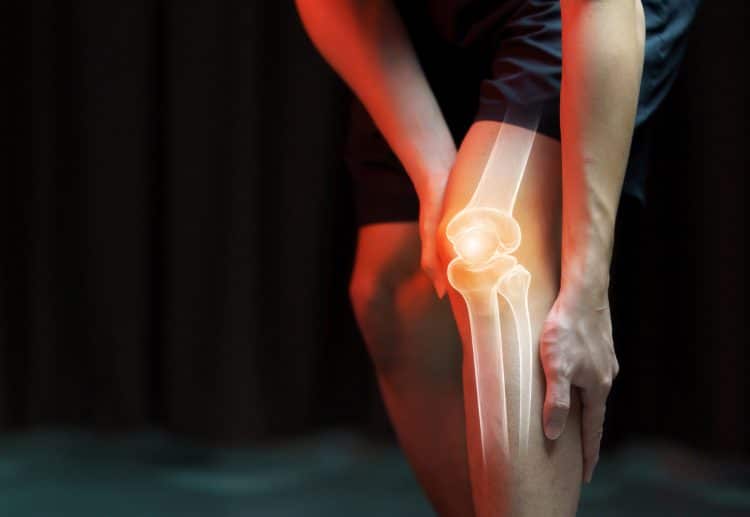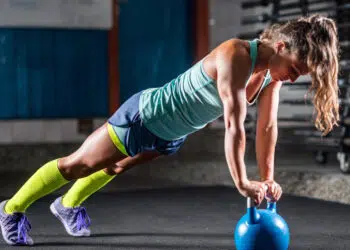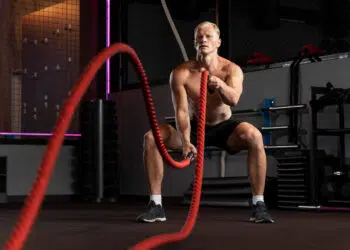Ask any exercise expert to name the best way to burn fat and get fit, and they’ll probably tell you that high-intensity interval training is the way to go. Known as HIIT for short, this popular training workout method involves alternating short periods of strenuous exercise with equally brief periods of incomplete rest. This sequence is then repeated usually six to ten times for a quick but brutal workout.
For example, you could sprint for 20 seconds on an exercise bike, pedal slowly for 40 seconds to recover, and repeat this sequence 12-15 times for a workout that takes less than a quarter of an hour.
There are set work-to-rest ratios for HIIT, and the length of each work and rest period depends on how hard you want to train. For example, some HIIT workouts involve long periods of work and short rests, while others feature briefer, more intense work periods, and longer rests.
In short, HIIT is flexible and can be adapted to suit a range of exercisers and their needs, from beginners to more advanced.
But HIIT is not the only interval-based fat-burning and fitness-building workout available. Sprint interval training offers many of the same benefits of HIIT and may even be better for some people.
In this article, we explain what sprint interval training is, reveal its advantages and benefits, discuss the drawbacks, and provide you with a few sample workouts to try.
Level Up Your Fitness: Join our 💪 strong community in Fitness Volt Newsletter. Get daily inspiration, expert-backed workouts, nutrition tips, the latest in strength sports, and the support you need to reach your goals. Subscribe for free!
What is Sprint Interval Training?
A sprint is an all-out effort. The aim of a sprint is to do the maximal amount of work in a given unit of time. If you get to the end of a sprint feeling like you could have gone faster or longer, you weren’t really sprinting.
From an intensity point of view, sprints are performed at 100%, with no pacing and nothing held back.
So, sprint interval training is an all-out sprint followed by a long, complete rest. This sequence is then repeated 3-6 times. Typically, with SIT, your work-to-rest ratio is 1:5 or even longer. So, if you sprint for 20 seconds, you’ll rest for 100 seconds or even longer before going again.
This is a stark contrast to HIIT, where work intervals are hard but somewhat submaximal, and rest periods are purposely short and incomplete.
A sprint interval workout is usually about the same duration as a HIIT workout. Still, with SIT, you spend less time training and more time resting.
In strength training terms, HIIT is like a bodybuilding workout. Your main aim is to create lots of fatigue through high training volume and short rests.
In contrast, SIT is like pure power or strength training, where you lift heavy weights for low reps and then take longer rests to avoid a decline in performance from set to set. SIT is all about quality over quantity.
On paper, SIT looks easier than HIIT, but the reality is quite different. HIIT is HIGH-INTENSITY, whereas SIT is MAXIMAL intensity.
The Advantages and Benefits of Sprint Interval Training
If you love HIIT, there is no reason to give up doing it. HIIT is a very effective way to work out. But, if you want to take your training to a new, higher level, SIT could be exactly what you’re looking for.
The advantages and benefits of SIT include:
Increased fat loss
SIT is a potent fat burner. Despite involving less work per training session, in studies, SIT outperformed HIIT for fat loss. In fact, SIT resulted in a 39.59% higher reduction in body fat percentage than HIIT (1).
Less training time and lower RPE
SIT involves shorter work periods and fewer sets per workout. While the training session itself is probably not that much shorter than HIIT, much more time is spent resting.
This may help lower the overall rating of perceived exertion (RPE) of the workout. Knowing you only have to do 3-5 sprints is mentally easier than thinking you’ve got to do 10 or 12, as is common with HIIT.
Increased muscle mass
Because sprinting involves 100% intensity for short periods, it taps into the type 2b fast-twitch muscle fibers responsible for muscle growth. These are the same muscle fibers targeted during bodybuilding training.
There is a reason that sprinters in all sports (athletics, swimming, track cycling, etc.,) are so muscular – it’s their body’s’ response to the type of training they do.
Improved speed and power
Your muscles won’t just get bigger by doing SIT; they’ll become more physically capable, too. SIT workouts involve generating maximal force, which improves neurological efficiency. Doing SIT will increase your speed and power, which could be very useful if you play a sport where sprinting plays a part, e.g., soccer or football.
Increased VO2 max
Despite SIT being a purely anaerobic training method, studies have shown that short but intense sprints can increase aerobic fitness, even in already fit individuals (2). That’s good news for anyone who wants to get fit but can only spare 20 or so minutes three times a week for exercise.
Related: Try our VO2 max calculator.
Quick results
SIT is so effective that you should start to see results in as little as four weeks (3). That’s because SIT is so intense that it triggers an “adapt or die” reaction within your body.
Your muscles and cardiorespiratory system have no choice but to make rapid physiological changes so that they can deal with the increased workload. So, if you want to get fit fast, SIT could help.
Level Up Your Fitness: Join our 💪 strong community in Fitness Volt Newsletter. Get daily inspiration, expert-backed workouts, nutrition tips, the latest in strength sports, and the support you need to reach your goals. Subscribe for free!
The Disadvantages and Drawbacks of Sprint Interval Training
While SIT is clearly an effective way to build fitness and burn fat, there are a few drawbacks to consider, too…
Injury risk
Doing any fitness activity at 100% intensity means there is a risk of injury (4). As such, SIT is best suited to intermediate and advanced exercisers who are robust enough to do SIT without risking injury.
Reduce your risk of injury further by always warming up before an SIT workout and using activities that are easy on your joints, e.g., air-bike, rowing machine, spin bike, elliptical, etc. Outdoor sprinting may be too high impact for some people and could cause serious injuries.
Also, you can’t really do SIT on a treadmill. They take too long to speed up and may not go fast enough to be considered a full-speed sprint. In addition, there is a real danger of falling off, which would probably be very painful.
Needless to say, you should warm up before a SIT workout to ensure that your muscles and joints are fully prepared for what you are about to do.
SIT requires a very specific mindset
It’s human nature to pace yourself and hold back a little. You’ll need to overcome this tendency if you want to get all the possible benefits from SIT. Instead, you’ll need to learn to push yourself to the limit, and that is a skill that may take time to develop.
You need to be patient during the rest intervals
Depending on your SIT workout, you could end up resting as long as four minutes between sprints. This is necessary for full recovery of ATP-CP and removal of lactic acid, so you can sprint at full speed for your next interval.
If you are used to HIIT and shorter rests, you may find it hard to hold yourself back for so long between sprints. However, long complete rests are critical for effective SIT workouts.
Sample SIT Workouts
You can create your own SIT workouts pretty easily; just do a short, hard sprint, rest for 5-8 times that duration, and repeat 3-5 times. Simple! But, to save you the effort, here are a few tried and tested sprint interval training workouts to try.
Note that the longer the sprint, the longer the rest is, and the fewer sets you’ll have to do to achieve the desired results.
1. 12 x 10 seconds sprint, 50 seconds rest (1:5 work to rest ratio)
Ten seconds might not sound like long but providing you really go for it, within a few sets, your muscles will be screaming for mercy! This is an excellent workout for anyone who enjoys high-intensity strength training.
Whatever exercise you do, make sure you turn the resistance up to the max and start speeding up five seconds before the start of each effort, so you hit top speed for the beginning of each brief interval.
2. 6 x 20-second sprint/2-minute recovery (1:6 work to rest ratio)
Longer sprints earn you longer rest periods, so you won’t need to do as many sets. This is a good mix of speed and training volume. 20 seconds can feel like a long time to sprint, but with two minutes rest between efforts, you should be well-recovered for each set, so you can still put 100% into each one.
3. 4 x 30-second sprint/4-minute recovery (1:8 work to rest ratio)
30 seconds is probably the longest time you can maintain a full-speed sprint. However, you’ll be pushing the envelope of what’s physically possible, which is why the rests are so long.
One way to approach this workout is to go 95% for the first ten seconds, 98% for the next ten seconds, and then 100% for the last ten seconds. While not pure SIT protocol, it’ll make this workout a little more manageable. As you become more accustomed to it, you can work toward hitting 100% for the entire duration of each set.
Wrapping Up
Low-intensity steady state (LISS) cardio, high-intensity interval training (HIIT), and sprint interval training (SIT) can all help you get fit, burn fat, get ripped, and improve your health. They all work differently, but the outcome is roughly the same.
So, which one is best?
The answer really depends on your exercise needs and preferences.
LISS is probably the way to go if you prefer an easy, long, almost meditative workout. But, if you want to feel your heart pumping, your lungs heaving, and your muscles burning, you’ll apt to enjoy HIIT more.
However, if you want to really test yourself and work to 100% of your exercising capacity, and maybe even get better results in less training time, SIT could be the workout for you.
Can’t decide which one to do? Simple rotate between LISS, HIIT, and SIT from one workout to the next and enjoy all of the benefits of these different workouts.
That said, in studies, SIT outperforms both LISS and HIIT for fat loss and fitness improvements, so it could be the best option if you are comfortable pushing your body to its limit.
References:
1. PubMed: Comparing Time Efficiency of Sprint vs. High-Intensity Interval Training in Reducing Abdominal Visceral Fat in Obese Young Women: A Randomized, Controlled Trial https://pubmed.ncbi.nlm.nih.gov/30123136/
2. PubMed: Effects of High-Intensity Interval Training vs. Sprint Interval Training on Anthropometric Measures and Cardiorespiratory Fitness in Healthy Young Women https://pubmed.ncbi.nlm.nih.gov/30568598/
3. PubMed: Four Weeks of Running Sprint Interval Training Improves Cardiorespiratory Fitness in Young and Middle-Aged Adults https://pubmed.ncbi.nlm.nih.gov/26514645/
4. PubMed: Injuries Sustained During High-Intensity Interval Training: Are Modern Fitness Trends Contributing to Increased Injury Rates? https://pubmed.ncbi.nlm.nih.gov/30758171/












